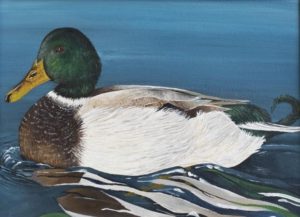Since 1938, the Federal Migratory Bird Hunting and Conservation Stamp or “Duck Stamp” has been required of anyone hunting ducks or geese, although anyone can purchase a duck stamp. The funds generated from these stamps have helped restore and improve important wetlands and the stamps have become collectors’ items. Duck stamps are one of the most successful wildlife restoration programs in the history of this nation.
Conservation through the arts: The Junior Duck Stamp Program (JDS), modeled after the Federal Duck Stamp, was launched in 1991 by the US Fish & Wildlife Service with the aim of increasing young people’s awareness of the importance of preserving wetland habitats and the delights of wildlife. In 1992, the US Fish and Wildlife Service printed the first ever Junior Duck Stamp with the funds used to provide awards, incentives, and scholarships to participating students, teachers, and schools.
This dynamic conservation program is designed to teach wetland habitat and waterfowl conservation to students in kindergarten through high school. Using scientific and wildlife observation principles, the program helps students communicate visually what they have learned by creating an entry for the Junior Duck Stamp Program art contest. The non-traditional pairing of subjects brings new interest to both science and the arts and teaches greater awareness of our natural resources. The art is judged in four age group categories in a statewide competition, and the entry judged Best of Show moves on to represent Massachusetts in the national JDS competition (which will be hosted by Massachusetts in 2020).
In Massachusetts the Junior Duck Stamp Program is sponsored by MassWildlife and the U.S. Fish and Wildlife Service.
Junior Duck Stamp educational curriculum: Created over two decades ago as an innovative way to teach youth about wetlands and waterfowl, nationally, the Junior Duck Stamp Conservation and Design Program reaches more than 27,000 students each year, giving them the opportunity to learn scientific principles, connect with their natural world, and artistically express their knowledge of the beauty, diversity and interdependence of wildlife. A redesigned educational curriculum has been developed that will spark students’ interest in habitat conservation and careers in natural resources through science, art, math, and technology. The curriculum guides meet a number of national education standards, including the National Science Education Standards, North American Association for Environmental Education Standards and National Visual Arts Education Standards.
You can support JDS by purchasing a stamp: The overall national winner of the art contest graces that year’s JDS and is sold by the U.S. Postal Service (www.usps.com or 1-800-782-6724) and Amplex Corporation (www.duckstamp.com or 1-800-852-4897) for $5. All proceeds of the stamp are invested in the program to fund environmental education programs; award the students, teachers and schools that participate in the program; and to market the JDS program.
Artwork submissions must be postmarked by February 15 of each year. For complete JDS program details visit, mass.gov/dfw/jds or contact: Pam Landry, Wildlife Education Coordinator (508) 389-6310, pam.landry@mass.gov. 
If you are a subscriber to Massachusetts Wildlife magazine, you are in for a real treat. In the most recent issue (No 3, 2019) there is a picture of artist Jenna Gormley when she was 5 years old and her Mallard artwork which was submitted to the JDS when she was 18 years old. Her article is entitled, “One Artist’s Journey with the Junior Duck Stamp Program”. When she was three years old, she was diagnosed with a receptive and expressive language disorder. She did not speak, so her form of communication was drawing pictures. 
It is a very interesting and inspiring article, so be sure to read it. If you are not currently a subscriber, click onto the MassWildlife web page, click onto Massachusetts Wildlife Magazine and follow the instructions. A 2-year subscription (8 copies) only costs $10.
Primitive Firearms Deer Hunting Season opens tomorrow
Shotgun deer hunting ended yesterday. If you haven’t gotten your deer yet, (don’t feel bad, you are not alone), you still have an opportunity to get one during the Primitive Firearms Deer Hunting season. It opens tomorrow and runs through December 31. A Primitive Firearms stamp is required and there are special regulations governing this season listed in the Massachusetts Fishing & Hunting official laws. Archers can hunt during this season but must purchase the Primitive Firearms stamp. Here’s hoping you have an enjoyable, successful and safe hunt trudging through our winter wonderland. Be careful and keep your powder dry.
Licenses are on sale now
The 2020 Massachusetts Fishing, Hunting and Trapping licenses are on sale now. They can be purchased online through MassFishHunt, at a license vendor location, or at a MassWildlife office. Good news! No increase in the license fees again this year.
MassWildlife suggests you use care when purchasing licenses during December, as both the 2019 and 2020 licenses are available.
Important studies ongoing by DFW
MassWildlife and the UMass Cooperative Fish and Wildlife Research Unit are working together to conduct fish surveys in rivers at current and former dam locations. So far, nearly 50 rivers have been surveyed as part of a broader project to more fully understand the impacts of dams and dam removals on fish and aquatic invertebrates. Coldwater fish like native eastern brook trout are particularly dependent on upstream and downstream movements for reproduction and survival. Previous research suggests that abundances of coldwater and coolwater fish, including brook trout, longnose dace, and white suckers, increase following dam removals. Monitoring will continue for the next several years.
MassWildlife and US Fish and Wildlife Service have completed a third year of cooperatively monitoring juvenile American shad in the Connecticut River. Biologists capture shad at night during the summer and fall using an electrofishing boat. Abundance, length, and weight measurements are collected and used to assess the growth, survival, and productivity of the population. This study is designed to help determine the impacts of dams on juvenile shad. Shad populations have significantly declined as a result of 19th century dam construction, which prevent adults from migrating upriver to find spawning habitat. Shad are an abundant food source for smallmouth and largemouth bass, walleye, perch, and northern pike. Shad also provide food for birds and terrestrial mammals, as well as marine fish including striped bass.
Don’t forget to submit your hunting logs
Massachusetts hunters spend a significant amount of time in the woods observing wildlife of all kinds. These observations can provide wildlife biologists with a tremendous amount of information to better understand wildlife distribution and abundance across the Commonwealth. If you are an archery deer hunter or a game bird hunter, perhaps you have been keeping a hunting log on all the days you hunted this season. These logs must be submitted before December 20, 2019 to be entered into a drawing. Prizes, donated by Cabela’s, include a Polar Cap Equalizer cooler (value $249.99) and two $25 Cabela’s/Bass Pro gift cards. Winners will be randomly selected and notified in late December. If you completed both types of logs, your name will be entered twice.
Gige has not been forgotten
Hard to believe but it has been a year since our old buddy George “Gige” Darey of Lenox passed away. As you may recall, he was the long time MA Fish & Wildlife Board Chairman (35 years), our greatest conservation champion and beloved by the outdoor sports community. He surely has not been forgotten. In fact, his partner, Ginny Acabane, noted that several people have recently approached her saying how much they still miss him.
Rumor has it that the Town of Ripton, MA will heretofore have a moment of silence in his memory each December 21.
